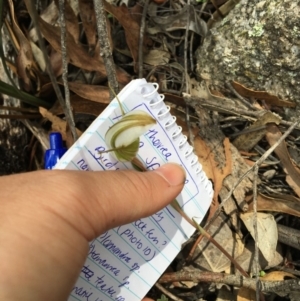Large Autumn Greenhood at Paddys River, ACT
Identification history
| Diplodium ampliatum | 7 Mar 2020 | MattM | ||
| Diplodium atrans | 7 Mar 2020 | kristi.lee@act.gov.au |
Identify this sighting
Please Login or Register to identify this sighting.
4 comments
MattM
wrote:
8 Mar 2020
Given the shape of the dorsal sepal (and fused petals) I would say this is D. revolutum. The tip of the dorsal sepal in atrans forms a more prominent point, almost like a needle. The dorsal sepal is also shorter in atrans, whereas it is broader and protrudes further forward in revolutum, and often lacks the pointed tip. D. atrans also appears to be quite rare in the ACT, perhaps because it prefers wetter areas. Your orchid looks like it is in dry forest, which is typical of D. revolutum. Another species you might find now is D. laxum, which differs from revolutum in that it has a black labellum.
kristi.lee@act.gov.au
wrote:
8 Mar 2020
Cool, thanks Matt! Do you know what the current status of D. revolutum is in the ACT? Is it of significant conservation value?
MattM
wrote:
8 Mar 2020
It's a pretty common orchid in these parts, and i don't believe it is of any significant conservation value either, but I wouldn't quote me on that. Some similar species are of high conservation value (e.g. Pterostylis aneba and oreophila), so it is always worth recording them as they can sometimes be difficult to distinguish.
At this time of year I would be looking out for Corunastylis spp. which are of greater conservation value, and current interest to Conservation Research. They are quite small, and hard to find if you are unfamiliar with them. Corunastylis clivicola (Rufous midge orchid) on 31 Mar 2018
Corunastylis clivicola (Rufous midge orchid) on 31 Mar 2018
At this time of year I would be looking out for Corunastylis spp. which are of greater conservation value, and current interest to Conservation Research. They are quite small, and hard to find if you are unfamiliar with them.
MichaelMulvaney
wrote:
9 Mar 2020
If you click on the latin name in red, the numbers at the top of the new page say that the species has been recorded 72 times in photographic sightings to CNM and 93 times from other records. If you click on the view distribution tab you can see its regional distribution. As Matt says it is quick widespread at lower altitudes,
Location information
- Maps Tidbinbilla Nature Reserve
- Places Paddys River, ACT
Sighting information
- 1 Abundance
- 7 Mar 2020 01:26 PM Recorded on
- kristi.lee@act.gov.au Recorded by
Species information
- Diplodium ampliatum Scientific name
- Large Autumn Greenhood Common name
- Sensitive
- Local native
- Non-Invasive
- 311 images trained Machine learning
-
In flower
- External link More information
-
Synonyms
Pterostylis revoluta Diplodium revolutum





